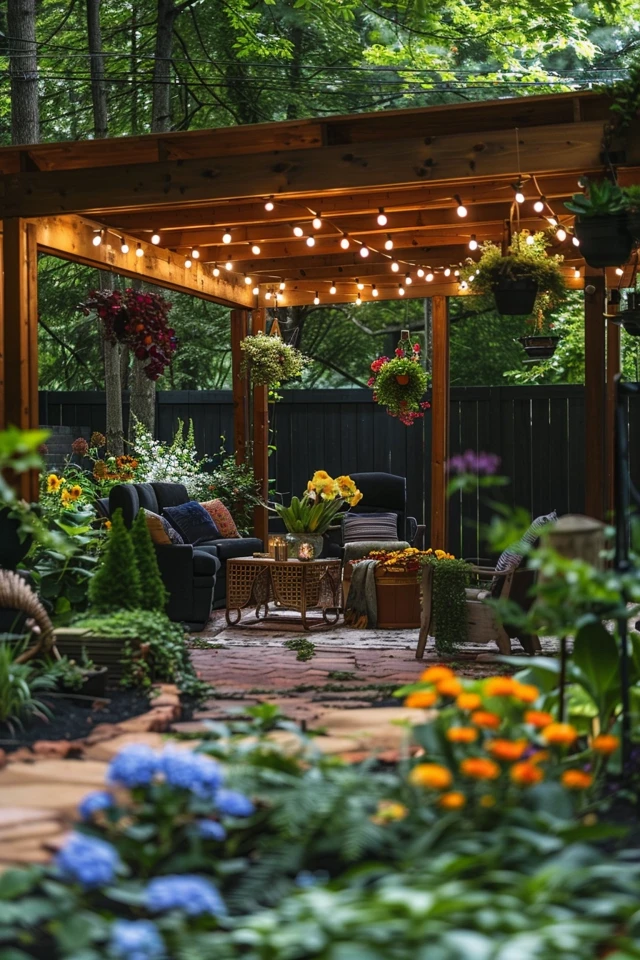Are you looking to transform your outdoor space into a serene oasis? Do you want to create a backyard that embraces the beauty of nature? In this section, I will explore a variety of wooded backyard ideas that will help you design a peaceful and enchanting outdoor space. From incorporating native plants to creating well-defined garden boundaries, these ideas will inspire you to create your perfect woodland sanctuary.
Key Takeaways:
- Design a natural backyard that blends seamlessly with the surrounding woodland.
- Use ground cover plants and native species to create a thriving woodland garden.
- Incorporate natural elements like garden trees and pathways made with natural materials.
- Add gateways and boundaries to define and enhance the beauty of your woodland garden.
- Consider the functionality and privacy provided by weathered wooden gates, hedges, and fences.
Creating a Woodland Garden with Ground Cover Plants and Natural Elements
Are you dreaming of a picturesque woodland garden filled with native plants and natural beauty? Look no further! In this section, I will guide you through the process of creating a stunning woodland garden design using ground cover plants and incorporating natural elements. Let’s dive in!
Ground Cover Plants: The Secret to Weed-Free Beauty
Ground cover plants are a game-changer when it comes to maintaining a weed-free and visually appealing garden. These low-growing plants not only help combat weeds but also prevent erosion, resulting in a healthier and more vibrant garden space.
- Wild Ginger: Native to shady woodlands, wild ginger (Asarum canadense) is an excellent choice for ground cover. Its heart-shaped leaves and unique burgundy flowers add a touch of elegance to any garden.
- Wild Strawberry: With its delicate white flowers and sweet, juicy fruit, wild strawberry (Fragaria virginiana) is a charming addition to your woodland garden. This ground cover plant spreads easily, creating a lush carpet of green.
- Blue Violet: Known for its striking purple flowers, blue violet (Viola sororia) thrives in moist, shady areas. It adds a pop of color and attracts pollinators to your garden.
- Canada Anemone: Canada anemone (Anemone canadensis) is a beautiful ground cover plant that prefers moist, well-drained soil. Its white flowers bloom in early summer, creating a stunning display of natural beauty.
- Mayapple: Mayapple (Podophyllum peltatum) is a unique ground cover plant that forms umbrella-like leaves. It thrives in woodland gardens and adds a touch of whimsy to the landscape.
By incorporating these native ground cover plants into your garden, you can create a thriving and low-maintenance space that blends seamlessly with the surrounding natural environment.

Creating a Natural Garden Oasis
To enhance the beauty and functionality of your woodland garden, it’s essential to incorporate natural elements. Garden trees, layered vegetation, and natural pathways can transform your garden into a tranquil oasis.
Start by selecting garden trees that are well-suited to your area’s climate and soil conditions. Consider native tree species such as oak, maple, or birch, as they provide shade and habitat for local wildlife.
“The trees are not only a visual anchor in the garden but also help create a microclimate that nurtures the growth of other plants,” says horticulturist Jennifer Smith.
In addition to trees, layering vegetation is another technique to add depth and interest to your garden. Plant taller perennials, such as hostas or ferns, in the back and shorter ones, like trilliums or foamflowers, in the front. This creates a visually appealing arrangement that mimics the natural growth patterns found in woodlands.
To connect different areas of your garden and create a natural flow, consider incorporating pathways made with natural materials. Use stepping stones, gravel, or wood chips to create a winding pathway that guides visitors through your woodland oasis.
With the combination of ground cover plants, native trees, layered vegetation, and natural pathways, your woodland garden design will harmoniously blend with the surrounding environment, providing a haven for both flora and fauna.

Enhancing Your Woodland Garden with Gateways and Boundaries
To create a well-defined woodland garden, it’s important to include gateways and boundaries. Incorporating garden gateways and setting clear garden boundaries not only adds visual appeal but also creates a sense of structure and security in your outdoor space.
Consider using weathered wooden gates as a charming entrance to your woodland garden. These gates not only blend beautifully with the natural surroundings but also add a touch of rustic elegance to your outdoor oasis. Laid hedges can be another fantastic way to define your garden’s boundaries and provide privacy. These lush green dividers not only create a sense of enclosure but also act as a natural backdrop for your garden’s beauty.
Dry-stone walls are another timeless option for enhancing your woodland garden. These sturdy and weathered structures not only provide a boundary but also add character and texture to your outdoor space. Stacked logs can serve as an alternative to walls, adding a rustic and organic touch to your garden’s design.
Incorporating tal hedges or wooden fences can be another effective way to protect your garden from unwanted wildlife and create a private sanctuary within the woodland setting. These vertical barriers not only keep animals out but also create a sense of seclusion, allowing you to enjoy your garden oasis in peace.


